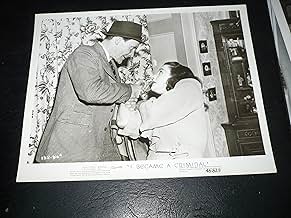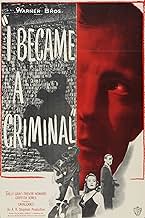Aggiungi una trama nella tua linguaAfter WW2, former RAF airman Clem Morgan joins a gang of black-market smugglers and thieves, but when a robbery goes wrong, Clem is caught, framed for a policeman's murder, and sent to priso... Leggi tuttoAfter WW2, former RAF airman Clem Morgan joins a gang of black-market smugglers and thieves, but when a robbery goes wrong, Clem is caught, framed for a policeman's murder, and sent to prison, where he plots his escape and revenge.After WW2, former RAF airman Clem Morgan joins a gang of black-market smugglers and thieves, but when a robbery goes wrong, Clem is caught, framed for a policeman's murder, and sent to prison, where he plots his escape and revenge.
- Regia
- Sceneggiatura
- Star
- Premi
- 1 candidatura in totale
Recensioni in evidenza
It does have Trevor Howard, as one of the bad guys this time. His riveting performance as a minor-league crook is matched by Griffith Jones's as a major-league mobster. Sally Gray turns in a strong performance too as the femme fatale who, at one point, takes a beating that she withstands stoically until a girlfriend cleans her up and, finally, gives her a cup of tea. It may be that kindness, or perhaps the hot tea on her split lip, you don't know, but Gray breaks down at last and you realize what the beating has done to her.
The pace is swift, but not rushed. Extraneous but fascinating scenes are included-scenes which lead nowhere-- particularly the homicidal lisping woman and her drunken husband who shelter fugitive Trevor Howard in their house for brief but very creepy period.
Every frame is composed with extraordinary care, especially in the climactic scene in the funeral parlor, a scene that reminded me of nothing so much as "Cabinet of Doctor Caligari." There's hardly a right angle in it. The chiaroscuro photography by Otto Heller ("Alfie," "Victim," "Peeping Tom," etc. etc.) is only enhanced by editing that's almost as whip-crack as the dialog.
And as for that superb dialog: film noir movies typically have wisecrack lines, but this Noel Langley screenplay is brilliantly terse-in league with Chandler's work. If any character had two sentences in a row, I didn't notice. It's all lickety-split exchanges, and every line adds definition or motivation to the character speaking.
A personal note: This is the only film I've ever watched which, after it finished, I immediately started it over and watched it again from the beginning. It was that rich, that engaging, and that satisfying.
This was pretty heavy stuff for 1947. References to cocaine, brutality towards women, and such goodies are noticeable here. Also noticeable is the noir type anti-hero magnificently portrayed by Trevor Howard, and lots and I do mean lots of shadows.
A rooftop scene was undoubtedly the prototype and inspiration for later movies such as To Catch A Thief.
Don't confuse this with the earlier Hollywood movie, They Made Me A Criminal, which featured John Grfield and the Dead End Kids. There's no similarity between those two films.
It features a splendid cast, all of whom deliver excellent performances: Trevor Howard is an unusual hero-type but totally credible; lovely leading lady Sally Gray may come off a bit too good to be true (she initially commits herself to the framed Howard merely because her gangster boyfriend has jilted her for the latter's own fiancée!) but she elicits all the petite sex appeal of a Veronica Lake (meanwhile her love/hate banter with Howard evokes memories of the Robert Donat/Madeleine Carroll pairing from Hitchcock's THE 39 STEPS [1935]); Griffith Jones is a suave yet ruthless leader of a black-market ring (but who gets his just desserts in particularly gruesome fashion); Mary Merrall is Jones' elderly associate, whose level-headedness and experience keeps the violent gangster in check; a young Ballard Berkeley is a sympathetic Scotland Yard man, but who doesn't think twice about using Howard as bait to capture the entire gang; Peter Bull turns up for a bit as a police informer.
The general gloominess (a mainstay of thrillers emanating from the post-war era) is leavened somewhat by its constant flurry of hard-boiled dialogue courtesy of screenwriter Noel Langley. The terrific climax is set inside the gang's 'business' office - a funeral parlor, amusingly named "The Valhalla Undertaking Co.". Still, perhaps my favorite scene in the entire film is Howard's surreal encounter with the zombie-like Vida Hope - in whose household he stumbles while on the run; she turns out to be deranged, and even tries to talk our hero into murdering her alcoholic husband (Maurice Denham)!
As is typical of old films released on DVD by Kino, the quality of the print and transfer leave a lot to be desired - but one has to be grateful still, because otherwise gems such as this one would remain unavailable indefinitely...
We've got a 1946/7 London - rainy, smog- and fog-ridden - swarming with sweaty, sadistic small-time black marketeers, hag-faced toothless harridan prostitutes, rat faced squealers, slimy grasses, heart-of-gold cashmere-wearing Judys, squalid, smoky dockside boozers, and bobbies in mackintoshes and capes (told you it was raining) getting run over and bashed over the coconut.
Enter ex-RAF Clem Morgan (Trevor Howard). He wants a bit of action with a gang led by sharp, smoothie, sadistic, snooker-playing knuckle-duster wielding Narcy (Narcissus)(Griffith Jones) - but he baulks at their drug (sherbert!) dealing side. So he's framed into a cop murder - very heavy stuff in immediate post-war England. But this isn't The Blue Lamp - it's nearer Jules Dassin's famous Night and the City and precedes both.
As well as a crackling script by Noel Langley we've got a runaway fugitive we know is innocent, more bobbies, more rain, and a head-butting, knife-throwing, rooftop-climbing finale.
A great British noir sadly often overlooked. See it!
Then too, consider the household Howard stumbles into by accident, where the zoned out housewife is only too eager to perforate her boozy hubby. One look at that demented visage and she's a lot scarier than any of the professionals. No wonder Howard flees back to the safety of London's underworld. This may also be the cheapest electricity bill on record since the brightest sound-stage bulb checks in at about 60 watts—they don't call it "noir" for nothing. And keep an ear cocked for some of the snappiest dialogue this side of Dashiel Hammett, especially from that old crone Aggie, who, I shudder to think, might actually be somebody's grandmother.
Not that everything is roses. Some of the set-ups operate only at a stretch. For example, Howard's aim with a milk bottle should have him pitching for the Yankees. And he does it with such casual flair, you'd never guess his life is on the line. Nonetheless, the movie's a real sleeper and should have been exported to our shores a lot sooner. I expect, that daring finale would have inspired our own filmmakers to greater sneaky lengths in subverting the dead hand of Hollywood censorship.
Lo sapevi?
- QuizTrevor Howard was cast at very short notice after the actor first cast dropped out.
- BlooperHe grabs the steering wheel in an attempt to avoid running down the Policeman, that is why his fingerprints are on the steering wheel.
- Citazioni
Mrs. Fenshaw: Nobody will arrest you while you are in this house. I give you my word.
Clem: Why? Have you fallen in love with my beautiful wavy hair?
Mrs. Fenshaw: No. You can do me a service in return for helping you.
- ConnessioniReferenced in A Man About a Film - Richard Dyer on Obsession (2024)
I più visti
- How long is I Became a Criminal?Powered by Alexa
Dettagli
- Data di uscita
- Paese di origine
- Lingua
- Celebre anche come
- I Became a Criminal
- Luoghi delle riprese
- Riverside Studios, Hammersmith, Londra, Inghilterra, Regno Unito(as Alliance Studios, Hammersmith)
- Aziende produttrici
- Vedi altri crediti dell’azienda su IMDbPro
- Tempo di esecuzione1 ora 41 minuti
- Colore
- Proporzioni
- 1.37 : 1
Contribuisci a questa pagina





























